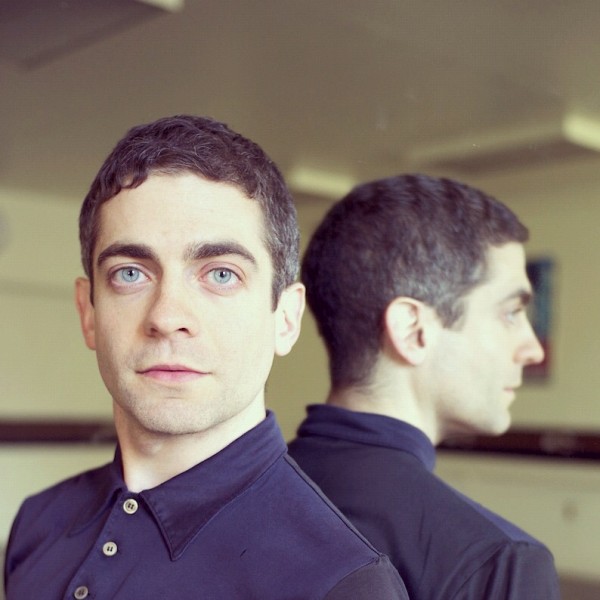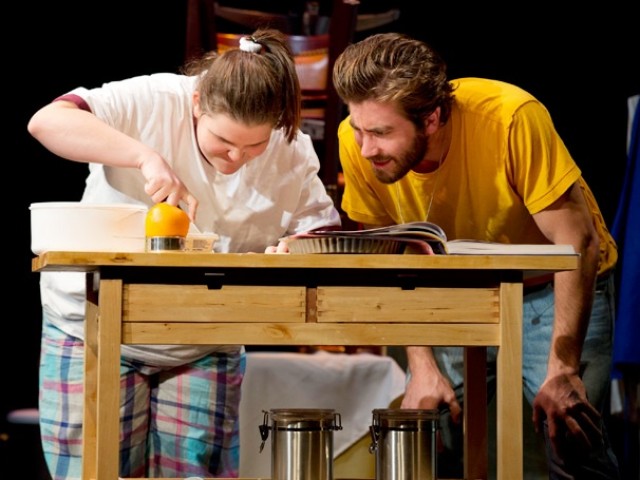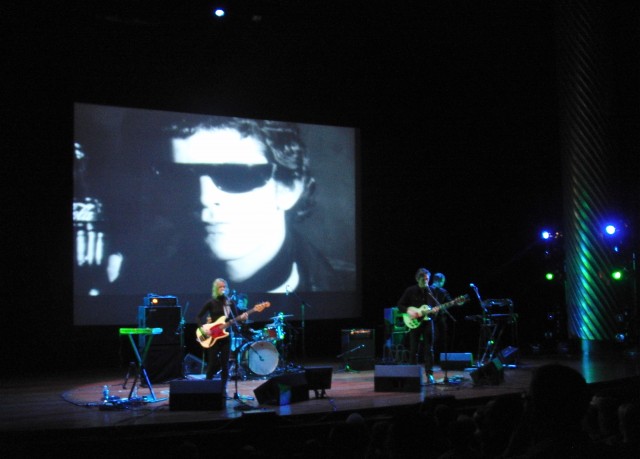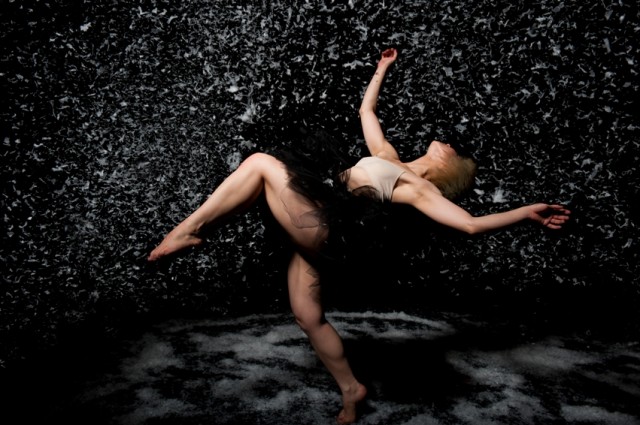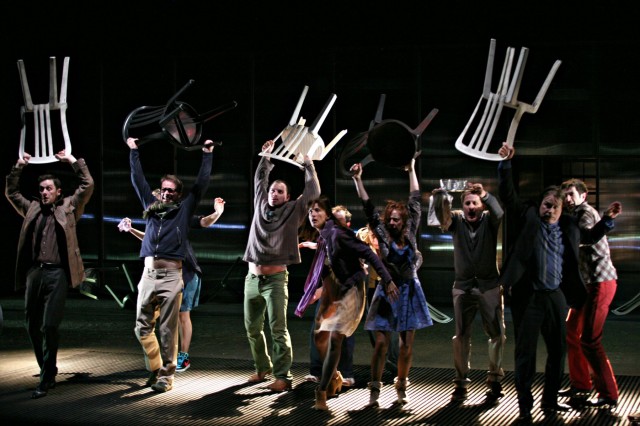
Théâtre de la Ville, Paris, will present Eugène Ionesco’s classic absurdist tale RHINOCÉROS this week at BAM (photo by Jean-Louis Fernandez)
BAM Howard Gilman Opera House
30 Lafayette Ave. between Ashland Pl. & St. Felix St.
October 4-6
718-636-4100
www.bam.org
www.theatredelaville-paris.com
As much as Jean-Paul Sartre is associated with the idea of existentialism, playwright Eugène Ionesco is linked with the word absurd. Born in Romania in 1909 and raised primarily in France, Ionesco changed the face of dramatic narrative with such works as The Lesson, The Chairs, The Killer, and Exit the King. One of his most famous plays, 1959’s Rhinocéros, which was turned into a 1973 film starring Zero Mostel, Gene Wilder, and Karen Black, can now be seen in an inventive adaptation by Emmanuel Demarcy-Mota and Théâtre de la Ville, Paris, running at BAM’s Howard Gilman Opera House October 4-6 as part of the thirtieth Next Wave Festival. “I like to come back to playwrights who question the place and role of the individual in collective history, on his responsibility, his freedom of thought, beyond any form of individualism,” Demarcy-Mota, who has also recently directed works by Horváth and Brecht, explains on the company website. The allegory about totalitarianism features set and lighting by Yves Collet, music by Jefferson Lembeye, and costumes by Corinne Baudelot, with François Regnault serving as artistic collaborator; Serge Maggiani plays Bérenger, Hugues Quester is Jean, and Valérie Dashwood takes on the role of Daisy. “”Ionesco knows how to depict dialectically every man’s cowardice, conformism and hypocrisy,” Demarcy-Mota adds. Rhinocéros “is a funereally burlesque play that we wish to render with full energy.” As a bonus, on October 5 at 5:00 at the Rosenthal Pavilion at NYU’s Kimmel Center, the esteemed panel of Demarcy-Mota, Edward Albee, Israel Horovitz, and Marie-France Ionesco will participate in the free “Next Wave Talk: On Ionesco,” moderated by NYU French literature professor Tom Bishop.
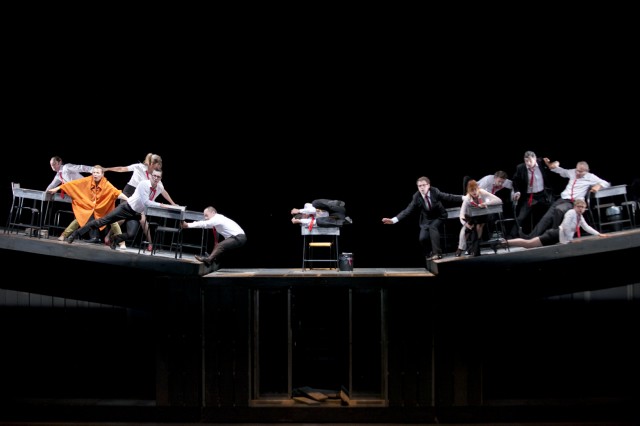
Nowhere is safe in Théâtre de la Ville’s thrilling production of Eugène Ionesco’s absurdist classic (photo by Pavel Antonov)
Update: Théâtre de la Ville director Emmanuel Demarcy-Mota promised a Rhinocéros rendered “with full energy,” and he and the company deliver all that and more in their engaging version of Eugène Ionesco’s 1959 absurdist classic, running October 4-6 at BAM’s Howard Gilman Opera House as part of the thirtieth Next Wave Festival. Following a short introductory excerpt from Ionesco’s sole novel, The Hermit, the curtain opens on a group of people in a town square just going about their daily business. Jean (a big, blustery Hugues Quester) bikes in to meet his friend Bérenger (Serge Maggiani), a bedraggled man recovering from a hangover, not able to remember much of what occurred the night before. A rhinoceros suddenly roars through the town like a tsunami, leaving in its wake a stunned crowd not quite sure what it really just saw, instead getting caught up in existential discussions of cats’ paws. Eventually life goes on, with Bérenger, who has a crush on Daisy (Valérie Dashwood), arriving at the publishing house where he works, only to encounter another stampeding rhino. As everyone around him starts turning into rhinos, the hapless Bérenger is determined not to succumb to the mass hysteria. Featuring terrific staging (courtesy of Yves Collet) that includes a raised-level office, collapsing rooms, and a majestically morphing figure in addition to a slowly building score by Jefferson Lembeye that nearly explodes at the end, Théâtre de la Ville’s Rhinocéros cleverly captures the philosophical underpinnings of Ionesco’s tale of the fight for individualism in the face of growing totalitarianism and an ever-increasing conformity that is overwhelming a consumer-driven society. Evoking Franz Kafka’s novella The Metamorphosis, Don Siegel’s sci-fi classic Invasion of the Body Snatchers, and such recent disasters as Hurricane Katrina and the 2011 Japanese earthquake and tsunami, the show combines humor, pathos, and playful investigations of logic as the community is overcome by a collective consciousness that seems unstoppable. Ionesco might have written Rhinocéros because of what he saw occurring in Eastern Europe in the 1930s, but it still feels as fresh and relevant as ever in this outstanding production.
